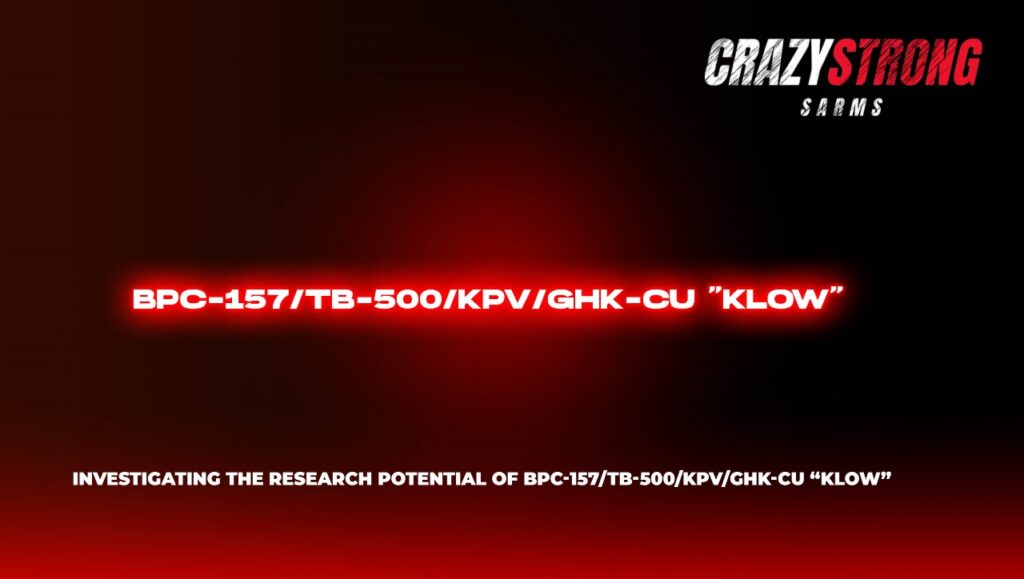The peptide science is developing at a very high rate. Scientists are currently focusing on multidimensional mixtures instead of individual mixtures. One such blend is BPC-157/TB-500/KPV/GHK-Cu “KLOW”.
This complex unites four peptides with different mechanisms. It allows researchers to have a multi-target model in studying regeneration, healing and inflammation. Hence, we will describe the function of each peptide and its potential combination.
Breaking its Components
BPC-157
BPC-157 is an artificial protein peptide based on a natural stomach protein. Existing research indicates that it is involved during angiogenesis, a process of the formation of new blood vessels. Since blood circulation contributes to tissue repair, this aspect is what makes BPC-157 a regular subject of research.
TB-500
TB-500 is a thymosin beta-4 analog synthesized in the lab. It affects migration and cell repair. Its activity is associated with much of actin, a protein that forms and moves cells. TB-500 could be involved in tissue recovery by assisting the actin activity.
KPV
KPV is a very small peptide that has been observed to have anti-inflammatory effects in pre-clinical studies. Research outlines that it is able to control some cues of inflammation. This prospect renders it a beneficial component of the mixtures aimed at recovery.
GHK-Cu
GHK-Cu is a copper-binding peptide. It is commonly associated with antioxidant action and collagen stimulation. It promotes tissue remodeling and skin regeneration.
These four components combine to create BPC-157/TB-500/KPV/GHK-Cu, known as “KLOW”, which is intended exclusively for laboratory applications.
Relevance in Gastroenterological Research
Digestive science is one of the fascinating fields to apply this mixture. As BPC-157 is conjugated to stomach proteins, the compound BPC-157/TB-500/KPV/GHK-Cu, referred to as KLOW, is typically used in a gastrointestinal health model.
Some of the research angles potentially useful to a gastroenterologist include:
Intestinal Inflammation
Diseases such as colitis are associated with chronic inflammation of the intestinal inner lining. Research can be done on the effect the blend has on mucosal healing. BPC-157 and TB-500 might be applicable in healing wounds, whereas KPV might be applied in controlling inflammation.
Ulcer Models
Peptic ulcers refer to injuries in the stomach. Studies examine the role of angiogenesis in healing ulcers. Since BPC-157 promotes the development of new vessels, it can increase the speed of repair in this type of model.
Barrier Integrity
High levels of intestinal barrier are essential to health. The effects of BPC-157/TB-500/KPV/GHK-Cu “KLOW” could be studied on tight junction proteins such as zonulin. This would illuminate gut permeability, which is an increasingly popular subject in contemporary gastroenterology.
Research Standards and Ethics
It is important to note that BPC-157/TB-500/KPV/GHK-Cu “KLOW” is intended for laboratory research only.
It is not permitted to be used as a direct medicine in both humans and animals. Those who work with peptide blends should adhere to specific ethical standards, precautions, and regulations.
The results of existing research are provisional. They are valuable data, which cannot and must not be used in clinical practice.
Conclusion
BPC-157/TB-500/KPV/GHK-Cu “KLOW” is a combination of multi-peptides having extensive research potential. It has four components, including angiogenesis, cell migration, inflammation, and tissue remodeling.
The studies of intestinal healing, healing of the ulcers, and the strength of the barriers demonstrate positive perspectives. Simultaneously, it is also being pursued in broader disciplines such as sports medicine, dermatology, and neurology.
Science is yet to reach its infancy, but prudent and ethical research will still yield essential findings. The study of blends such as BPC-157/TB-500/KPV/GHK-Cu KLOW helps in increasing the understanding of biological repair. This can assist in the future development of biomedical science responsibly.

